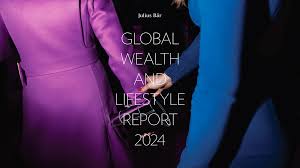Living well is not cheap. Living well in major cities comes with costs that not everyone can afford, creating a distinction between large metropolises and other cities.
The Global Wealth and Lifestyle Report 2024, prepared by investment bank Julius Baer, details the lifestyles and consumption trends of high-net-worth individuals (HNWI) in 15 countries across Europe, APAC, the Middle East, Latin America, and North America.
According to the data provided, the impact of the global pandemic has stabilized into a “new normal.” However, inflation, rising living costs, and geopolitical tensions continue to affect prices and priorities globally.
In 2024, price increases slowed to an average of 4%, measured in dollars, compared to 6% in 2023. This year, the prices of goods grew more rapidly than those of services: 5% versus 4%, also measured in dollars. Although cities continue to become more expensive, inflation rates have normalized over the past 12 months.
The city’s ranking is based on the Julius Baer Lifestyle Index, which analyzes the cost of a basket of goods and services representative of “living well” in 25 cities worldwide.
Regions and Their Cities
This year saw significant shifts in the rankings of major cities and, consequently, the regions for “living well,” based on the index’s performance.
Singapore once again ranked as the most expensive city in the world, while Hong Kong moved to second place from the third position it held in the previous report. However, this was not enough for the Asia Pacific region (APAC) to retain the top spot, and it fell to second place for the first time in the regional ranking. This was due to the decline observed in cities like Tokyo and the significant advance of the European region.
Thus, the Europe, Middle East, and Africa region, defined by Julius Baer as EMEA, displaced APAC from the top spot. This is a significant advance considering that in last year’s report, it was the cheapest region for “living well,” now becoming the most expensive.
The performance of London, which moved from fourth to third place, and the rise in all European cities, without exception, explain the region’s increase in the index. This year, Zurich climbed eight places, while Milan and Paris rose six and five places, respectively.
The appreciation of the region’s most representative currencies (euro and Swiss franc, except for the British pound) also explains this positioning.
In the Americas, both New York and São Paulo remain among the top ten most expensive cities for “living well.”
In city measurements, New York dropped from fifth to seventh place, while São Paulo remained in ninth place. However, Miami fell from 10th to 15th place, and the big surprise was Ciudad de México, which made a significant leap to 16th place from 21st the previous year.
Currency Fluctuations Are Determinants
Overall, currency fluctuations play an important role in determining changes in the index, says Julius Baer in its report, impacting both upward and downward movements.
“Although costs barely changed in local currency, conversion to U.S. dollars made the difference. The index prices are converted to dollars to allow for international comparison. Therefore, the strength of currencies like the Swiss franc and the relative weakness of currencies like the Japanese yen are clearly reflected in the results of these cities,” the company stated in its report.
Christian Gattiker, Head of Research at Julius Baer, commented: “This year’s report demonstrates that currencies are very important. For example, in the 1990s, Tokyo was the epitome of an ultra-expensive city. However, the gradual decline of the yen has shown that this can change. Although it may seem trivial, we tend to forget that the cost of living can look completely different for a foreigner thinking in U.S. dollars or Swiss francs instead of the local currency. Currency and context make the difference.”





 For Fórmate a Fondo
For Fórmate a Fondo